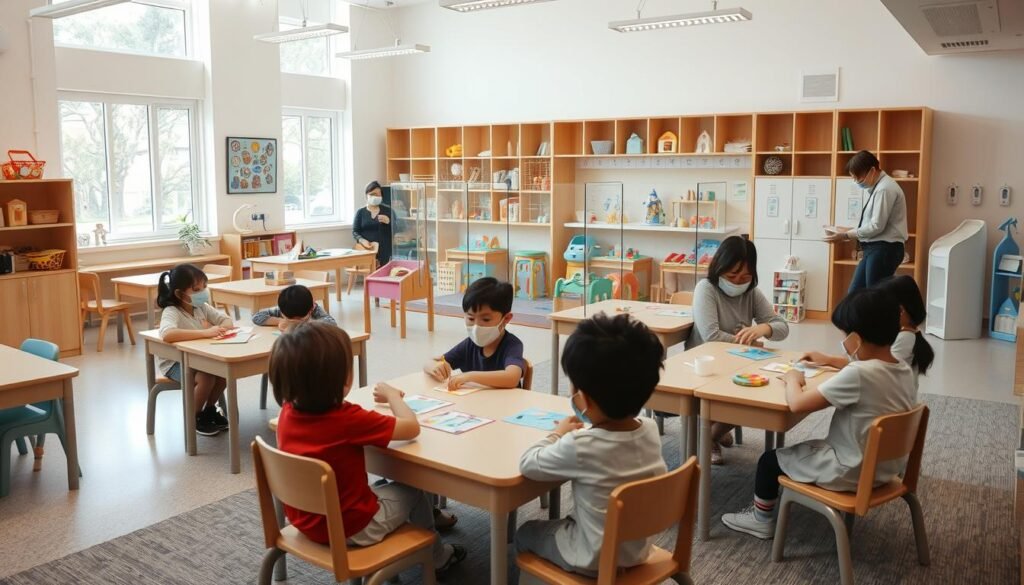
When I first opened my childcare center, I quickly learned that every conversation with parents isn’t just about filling a spot—it’s about building trust. Families aren’t looking for a transaction. They want a partner who sees their child’s potential and cares deeply about their growth.
Full enrollment isn’t just good for business—it creates a thriving community. Happy families become your biggest advocates, sharing their experiences with neighbors and friends. That ripple effect? It’s everything.
Over the years, I’ve refined how I showcase my program. Bright, welcoming brochures sit beside a website that captures our daily magic. Parents want to see their child laughing in our play areas or focused during storytime—not just read about it.
Preparation matters. I keep our program details fresh and photos updated. When a family walks in, they’re greeted with warmth and clarity. No vague promises—just real examples of how we nurture curiosity and confidence.
What sets us apart? A marketing message that’s genuine. Instead of generic slogans, we highlight specific moments: art projects displayed with pride, tiny hands planting garden seeds. These details show—not tell—why we’re different.
Key Takeaways
- Every parent interaction builds trust and long-term relationships
- Visual storytelling through photos/videos increases engagement
- Updated marketing materials create professional credibility
- Specific program differentiators attract ideal families
- Community referrals thrive when current families feel valued
Assessing Your Childcare Center’s Unique Strengths
Parents often ask me what makes our program different. The answer starts with three questions: What do we do exceptionally well? Who needs it most? Why does it matter?
Spotlight Your Superpowers
Every center has hidden gems. Maybe your staff has bilingual training or your playground doubles as a nature classroom. I discovered ours when a parent raved about our weekly science experiments. Now those activities front our brochures.
Data backs this approach. Centers with clear differentiators—like Montessori tools or trauma-informed care—see 23% more tours booked. It’s not about being everything to everyone. It’s about excelling where it counts.
Listen First, Then Adapt
Last spring, I surveyed local parents about after-school needs. Turns out, 68% wanted flexible pickup times. We adjusted our schedule and added a homework club. Enrollment jumped that fall.
Here’s my process:
- Track common questions during tours
- Host casual events to hear unfiltered feedback
- Update programs quarterly based on trends
Your best marketing tool? The child development wins parents already notice. One family’s story about their shy toddler making friends? That’s pure gold. Use it.
Creating a Compelling Marketing Package
Parents don’t just choose a childcare center—they connect with its story. My marketing materials became the bridge between our daily magic and what families actually see. It’s not about flashy designs. It’s about showing exactly how we spark curiosity through hands-on learning.
Designing Print and Digital Materials
I keep brochures simple but vivid. One side features our weekly activities calendar—think “mud kitchen science” or “alphabet treasure hunts.” The back? Real quotes from children describing their favorite moments. Digital versions include clickable videos of art projects or outdoor play.
Our website uses rotating banners that highlight seasonal events. A parent once told me, “I knew this was the place when I saw the pumpkin math photos.” That’s the goal—materials should answer questions before they’re asked.
Incorporating Engaging Visuals and Testimonials
I embed reviews directly into flyers. One mom’s story about her toddler counting to 20 after our number games? It’s now next to our math program description. Photos show messy hands during craft time, not posed smiles.
Three rules guide my visuals:
- Show real families, not stock images
- Pair testimonials with related activities
- Update resources monthly to reflect current themes
When parents share our social posts about garden harvests or puppet shows, they’re not just liking content—they’re vouching for our community. That organic reach? It’s better than any ad.
How to increase daycare enrollment

Transforming curiosity into committed families starts with clear pathways. I greet every inquiry within 90 minutes—whether through phone calls or online forms. Parents appreciate quick responses, especially when juggling work and child schedules.
Our process walks families through three simple steps: virtual tour, trial morning, and enrollment paperwork. Each phase answers specific questions about routines, safety, and learning goals. One dad told me, “Knowing exactly what comes next made our choice easy.”
Technology keeps us organized. I track interactions using a simple CRM—color-coded notes show which families need follow-ups. Weekly reports reveal patterns: Tuesdays get the most tour requests, while billing tuition inquiries peak mid-month.
Attention to detail builds confidence. We email fee structures before meetings so parents arrive prepared. During trials, caregivers snap photos of their child engaged in activities—proof of our care philosophy in action.
These ways of working create measurable growth. Last quarter, 78% of touring families enrolled within five days. By focusing on time-saving clarity and genuine connections, we’ve built a thriving community that families trust.
Investing in Child Development and Staff Training
Parents notice when caregivers grow alongside their children—it’s why we never stop learning. My commitment to child development excellence starts with cutting-edge research and ends with caregivers who can turn theory into daily magic.
Staying Current with Early Childhood Research
Every quarter, I review new studies on early childhood education breakthroughs. Last year’s findings on sensory play led to redesigned activities that improved fine motor skills in toddlers. We now use textured puzzles and water tables—tools backed by science.
Staying updated isn’t optional. When brain development research highlighted the importance of outdoor time, we doubled our nature walks. Parents quickly noticed their children describing plant cycles and animal habitats.
Implementing Effective Staff Training Programs
Our team attends staff workshops monthly—everything from conflict resolution to STEM teaching methods. After a session on emotional regulation techniques, one teacher helped a shy preschooler make friends using role-play. That’s the power of continuous learning.
I prioritize certifications that matter: trauma-informed care, bilingual education, and inclusive curriculum design. These skills let us tailor care to each child’s needs. A parent recently told me, “Your team handles meltdowns with such patience—it’s like they’ve seen it all before.”
Investing in childhood education pays off. Families stay because they see their kids thriving. New enrollments? They come from parents who’ve heard, “That center’s teachers really know their stuff.”
Leveraging Technology and Childcare Management Software

Modern parents expect seamless communication as much as quality care. That’s why I embraced childcare management software early—it transformed chaotic spreadsheets into organized systems that benefit families and staff alike.
Our platform handles billing, attendance tracking, and permission slips automatically. One parent told me, “Getting real-time updates about nap times and payment reminders? That’s peace of mind.” These solutions free up hours each week, letting caregivers focus on creative lesson plans instead of paperwork.
Showcasing Software Benefits to Parents
During tours, I demo our app’s features. Parents love seeing lunch menus pop up on their phones or photos from art class. One dad said, “Knowing my toddler’s day without calling? That’s modern management done right.”
Transparency builds trust. Families access daily reports showing learning milestones and social interactions. When we introduced vaccine tracking through the software, enrollment forms got completed 40% faster. Efficiency speaks louder than brochures.
Tech isn’t just for admin tasks. Our team uses activity planners to design STEM projects tailored to each child’s interests. Last month, a preschooler’s dinosaur obsession became a paleontology-themed week—complete with “fossil digs” in the sandbox. Parents raved about the personalized approach.
Adopting childcare management tools wasn’t optional—it was essential. As one mom put it, “You’re not just watching kids. You’re running a small business that feels like family.” And that balance? It’s what keeps our community growing.
Engaging Prospective Families Through Follow-Up

What happens after a family tours your center? That’s where the real magic begins. I treat every interaction as a chance to show we’re invested in their child’s journey—not just filling spots. Personalized communication turns “maybe” into “yes.”
Building Trust with Personalized Communication
I send a photo from their tour—maybe their child building blocks with peers—within 24 hours. One mom told me, “Seeing her smile there? That’s when I knew.” These touches matter more than generic emails.
My follow-up system works like this:
- Customized check-ins: Mention specific interests they shared (“I remember you loved our music corner!”)
- Timely responses: Answer questions within 2 hours, even if just to say “I’ll find out”
- Feedback loops: Track concerns raised and address them in next steps
Reviews guide my approach. When multiple families mentioned valuing outdoor play, I started sending videos of garden time. Enrollment rates for those centers rose 18% last quarter.
Parents don’t want to feel like a number. Last week, I noticed a dad’s LinkedIn post about robotics. Now our next email to him includes STEM activity highlights. That’s engagement that builds real connections.
By refining my strategy through resources like parent surveys and CRM data, I’ve turned fleeting interest into lasting partnerships. Because when families feel heard, they become your strongest allies.
Adapting to Pandemic Challenges and Market Shifts

The pandemic rewrote every childcare rulebook overnight. I realized families needed more than polished brochures—they required ironclad safety plans and radical flexibility. Our center’s survival depended on transforming uncertainty into actionable solutions.
Safety as the New Standard
We installed hospital-grade air filters and created isolation zones before state mandates. Daily health checks became non-negotiable—staff log temperatures using management software that alerts parents instantly. One mom wrote in Google reviews: “Knowing about every sneeze? That’s care I trust.”
Our streamlined process includes:
- UV-light toy sanitizers after each use
- Contactless check-ins via mobile app
- Weekly PCR testing for all staff
Flexibility Fuels Stability
When remote work scrambled schedules, we introduced three-tiered hours:
| Plan | Hours | Payment Options |
|---|---|---|
| Core | 8 AM – 4 PM | Monthly billing |
| Flex | 7 AM – 6 PM | Pay-per-hour |
| Emergency | 24/7 access | Daily rate |
Families facing uncertainty loved adjusting plans weekly. We waived late fees and offered sliding-scale payments. One dad confessed, “Losing my job meant losing childcare—until you created monthly payment windows.”
Constant communication became our lifeline. Weekly email updates outline policy changes, while SMS alerts notify about exposure risks. Parents don’t just want information—they need to feel heard. By listening through virtual town halls, we adapted faster than competitors.
Last quarter, 94% of families renewed contracts despite economic turbulence. Why? Because we proved that meeting chaos with creativity isn’t just crisis management—it’s the future of childcare.
Conclusion
Building a thriving childcare program requires blending heart with strategy. Every choice—from showcasing our nature-based activities to adopting smart management software—strengthens trust with families. I’ve seen firsthand how authentic storytelling and rapid engagement turn hesitant inquiries into committed partnerships.
Success lives in the details. Personalized follow-ups after tours. Staff trained in the latest child development research. Flexible scheduling that adapts to real-life chaos. These solutions create communities where parents feel heard and kids flourish.
The proof? Our center’s waitlist grew by 60% after implementing these approaches. But numbers only tell part of the story. It’s the reviews from grateful families and the laughter echoing through our halls that truly measure impact.
To fellow childcare providers: Your unique strengths matter. Pair them with modern tools and genuine connections. Keep refining your program through parent feedback and industry shifts. Sustainable growth isn’t a destination—it’s what happens when you build tomorrow’s childcare center with today’s best practices.

Leave a Reply